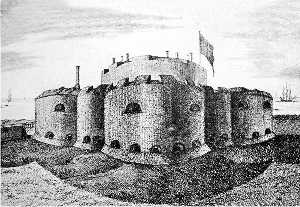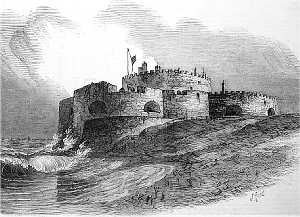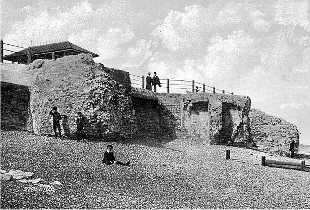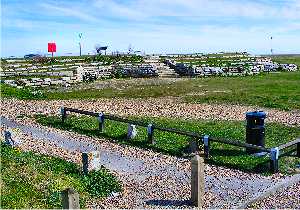 |
 |
|
| Sandown Castle - an artist's impression from 1735. | Waves lash against Sandown Castle in an 1853 illustration. | |
 |
 |
|
| Sandown Castle seen from the beach in the early 1900s. | Sandown Castle remains - today (photo: Harold Wyld) |
Henry VIII's fears of invasion led him to build a number of coastal forts. The main ones were at Sandown, Deal, Walmer, Camber, Sandgate, Calshot, Hurst, Portland, Pendennis and St Mawes. The first three were among the first to be built - over an 18-month period in 1539 and 1540. Spaced with little more than a mile between each of them, a prime function of the three castles was to protect a vital off-shore anchorage, known as The Downs.
Sandown Castle comprised a circular central tower, 83 feet in diameter, surrounded by four lower semi-circular bastions serving as artillery platforms. Entry to the castle was on a drawbridge over a dry moat and leading to a portcullis in one of the bastions.
A Role in the Civil War
Henry's invasion fears came to nothing and the diminished threat led to Sandown and its neighbouring castles being allowed to fall into disrepair by the early 1600s. The outbreak of the English Civil War in August 1642 saw the three local castles held by Royalist forces. This was short-lived and, after a week, they were seized by the Parliamentarians.
The Royalists reoccupied the castles during a revolt of 1648. Parliamentary forces responded, recapturing Walmer Castle on 12 July 1648, Deal Castle on 25 August and Sandown Castle on 5 September. In the midst of all this, the Parliamentary forces also had to deal with landings by Royalist supporters from some ships in The Downs and a force led by the exiled Prince of Wales and Prince Rupert. Several fierce battles ensued with the Royalists sustaining serious losses and being forced to escape by boat.
With the Restoration of the Monarchy in 1660, Charles II set about punishing those who were involved in the execution of his father. One of these was Colonel John Hutchinson (1615-1664), one of the signatories on Charles I's death warrant in 1649. On 11 October 1663 he was arrested and sent to the Tower of London and in May 1664 he was transferred to Sandown Castle. The colonel was never brought to trial and died at Sandown on 11 September 1664.
The 18th and 19th Centuries
In his book Records of Walmer (1890) Charles Elvin gives an account of Sandown Castle in the 18th and 19th centuries. He refers to storm damage in 1786 breaking through the outer wall of the moat and rendering the castle "barely habitable". In 1793, the encroachments of the sea were said to have made it "unfit for habitation".
However, concerns at events across the Channel in the French Revolutionary War when an invasion from Bonaparte's forces at Boulogue seemed imminent, saw the castle repaired and once more garrisoned with soldiers. Charles Elvin's book goes on to record installation of newly designed Armstrong breech-loading guns in January 1860. He notes that in December 1862 the sea-wall at Sandown Castle was breached again and the moat filled with water. In 1863 the unusable castle was sold off by the War Office. Some of the stone was used to construct the abutment of Deal Pier and in 1864 the central tower and upper tower and the upper part of the bastions were pulled down.
Further demolition occurred in 1882 leaving just the seaward walls of the castle. The sea continued to undermine the structure and fears for public safety led to demolition in February 1894. The work, involving use of explosives, was carried out by the 37th Field Company Royal Engineers based at Shorncliffe near Folkestone.
The 1900s
The following century saw steady loss of what little remained with much of the material being incorporated in sea defences. In February 1983 heavy seas swept away the beach north of the ruin, exposing some inner walls of the moat. Subsequent improvements to sea defences mean there is now very little outward sign of the castle.
Early in 2015, a group of local residents decided to transform the remains of the castle ruins into a community garden. Their efforts paid off and have been recognised by a number of awards in national and regional "bloom" competitions.
| There's more on Sandown Castle on the following websites.... |
| English Heritage's "Pastscape" national monuments record: www.pastscape.org.uk/... |
| Wikipedia encyclopaedia entry at: Wikipedia.../Sandown_Castle. |